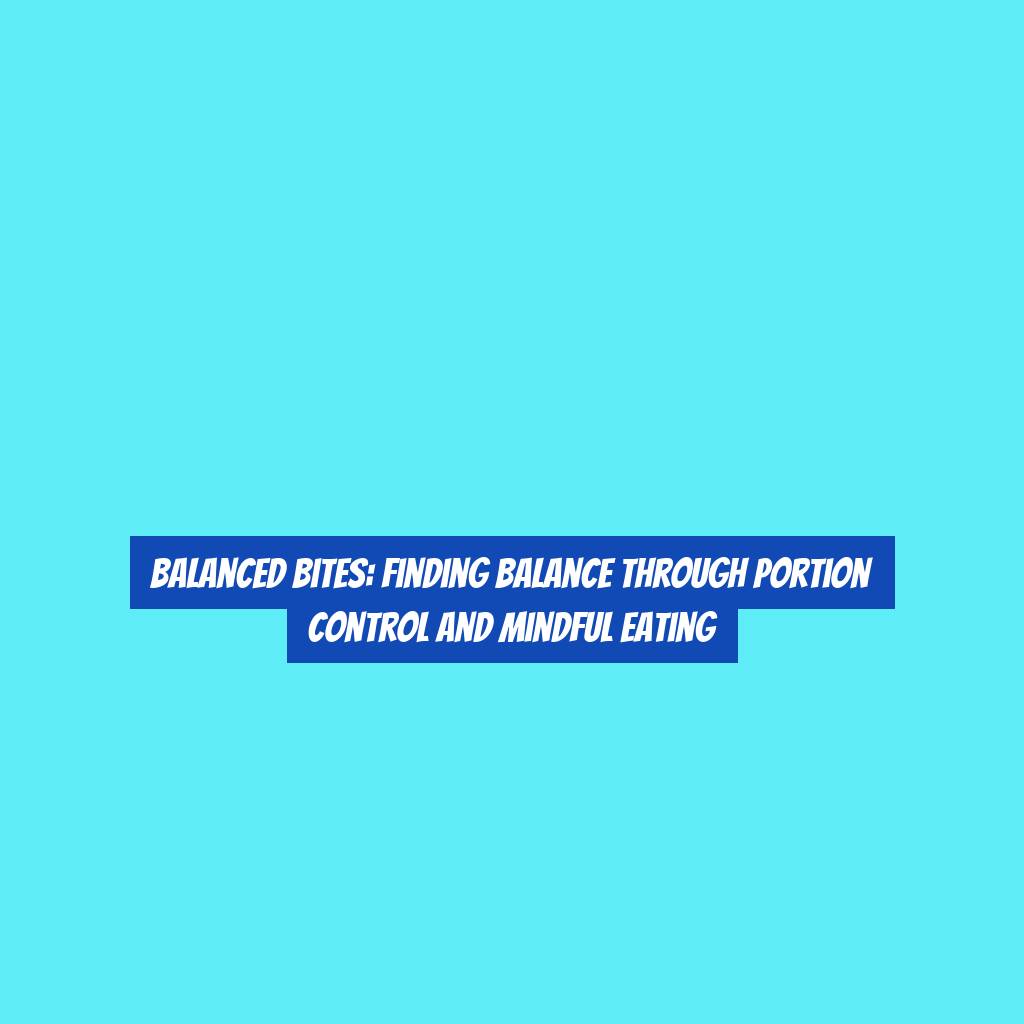Balanced Bites: Finding Balance Through Portion Control and Mindful Eating
So, youG??ve tried every fad diet and trendy eating plan out there, only to find yourself right back where you started? ItG??s frustrating, we get it. But what if we told you that finding balance through portion control and mindful eating could be the key to finally achieving a sustainable and healthy relationship with food?
Imagine being able to enjoy your favorite foods without the guilt or the fear of overindulging. Now, what if we told you that itG??s entirely possible, and it doesnG??t involve any extreme restrictions or complicated rules? Sounds intriguing, doesnG??t it?
The Importance of Portion Control
To maintain a healthy diet and manage your weight effectively, understanding the importance of portion control is essential. By controlling your portion sizes, you can ensure that you arenG??t overeating and consuming more calories than your body needs. Portion control also helps in preventing the feeling of being too full or bloated after a meal. It allows you to enjoy a wide variety of foods without feeling deprived while still maintaining a balanced intake of nutrients.
Additionally, practicing portion control can aid in regulating blood sugar levels, which is crucial for overall health, especially for individuals with diabetes or insulin resistance. It can also contribute to better digestion and reduce the risk of heartburn and indigestion. Moreover, being mindful of portion sizes can assist in preventing nutrient deficiencies by allowing you to consume a diverse range of foods in appropriate amounts.
Understanding the importance of portion control empowers you to make conscious choices about what and how much you eat, leading to a more balanced and healthier lifestyle. ItG??s a simple yet powerful tool for achieving and maintaining a well-rounded, nutritious diet.
Practicing Mindful Eating Techniques
Understanding the importance of portion control empowers you to be more conscious of your eating habits and develop mindful eating techniques that can enhance your overall relationship with food. Practicing mindful eating techniques involves being fully present and engaged with the act of eating. It allows you to savor each bite, appreciate the flavors and textures, and tune into your bodyG??s hunger and fullness cues.
To practice mindful eating, consider the following techniques:
-
Engage Your Senses: Before taking a bite, take a moment to observe the colors, textures, and aromas of your food. This helps to awaken your senses and cultivate a deeper appreciation for the meal.
-
Chew Thoroughly: Focus on thoroughly chewing your food, allowing yourself to fully experience the taste and texture. This also aids in digestion and gives your body time to signal when itG??s full.
-
Eliminate Distractions: Minimize distractions such as electronic devices or reading material while eating. By focusing solely on your meal, you can better recognize feelings of satisfaction and prevent overeating.
Strategies for Balanced Meal Planning
Balanced meal planning involves considering a variety of nutrient-dense foods to create meals that support your overall health and well-being.
Start by dividing your plate into sections: half for vegetables and fruits, a quarter for lean proteins, and a quarter for whole grains or starchy vegetables. This visual guide can help you ensure that youG??re getting a good balance of nutrients.
Another strategy is to plan your meals ahead of time. Take some time at the beginning of each week to plan out your meals and snacks. This can help you make healthier choices and avoid last-minute unhealthy options.
Additionally, consider batch cooking. By preparing larger quantities of food at once, you can have meals ready to go throughout the week, saving time and ensuring that you have nutritious options available.
Lastly, be mindful of portion sizes. Use smaller plates and bowls, and pay attention to serving sizes recommended on food labels. These strategies can help you plan and create balanced meals that support your health and well-being.
Creating a Positive Relationship With Food
Building a positive relationship with food involves understanding your bodyG??s hunger and fullness cues and practicing mindful eating habits. ItG??s about fostering a healthy and balanced approach to food that nourishes both your body and mind. Here are some key steps to help you create a positive relationship with food:
-
Listen to Your Body: Pay attention to your bodyG??s hunger and fullness signals. Eating when youG??re hungry and stopping when youG??re comfortably full can help you develop a healthier relationship with food.
-
Practice Mindful Eating: Engage all your senses while eating. Take the time to appreciate the flavors, textures, and aromas of your food. This can help you savor each bite and become more attuned to your bodyG??s needs.
-
Embrace All Foods: Avoid labeling foods as G??goodG?? or G??bad.G?? All foods can have a place in a balanced diet. Enjoying a variety of foods in moderation can help you cultivate a positive and flexible attitude toward eating.
Mindful Eating for Long-Term Wellness
To maintain long-term wellness through mindful eating, itG??s essential to cultivate a deep awareness of your bodyG??s signals and responses to food. When you practice mindful eating, you focus on the present moment, paying close attention to the taste, texture, and overall experience of each bite. By doing so, you can better tune in to your bodyG??s hunger and fullness cues, preventing overeating and promoting a healthier relationship with food.
Mindful eating also involves being attuned to your emotional and psychological state when you eat. ItG??s about recognizing the triggers that lead to mindless or emotional eating and finding alternative ways to cope with those feelings. By addressing these triggers, you can develop a more balanced and sustainable approach to eating that supports your long-term wellness goals.
Furthermore, mindful eating encourages you to savor your meals and appreciate the nourishment they provide. Taking the time to chew slowly and savor the flavors not only enhances your enjoyment of the food but also allows for better digestion and nutrient absorption.
Incorporating mindfulness into your eating habits can lead to lasting improvements in overall wellness, helping you build a healthier relationship with food and sustainably manage your weight and well-being.
Conclusion
Remember, finding balance through portion control and mindful eating is a journey, not a destination.
By being mindful of your portion sizes and practicing mindfulness techniques, you can create a positive relationship with food and promote long-term wellness.
Take the time to plan balanced meals and savor each bite, being present in the moment.
With these strategies, you can achieve a healthier and more balanced lifestyle.






